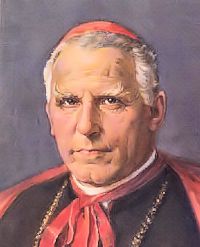Lent: March 22nd
Thursday of the Fourth Week of Lent
Other Commemorations: Bl. Clemens August von Galen, Bishop (RM)
» Enjoy our Liturgical Seasons series of e-books!
But I have testimony greater than John's. The works that the Father gave me to accomplish, these works that I perform testify on my behalf that the Father has sent me. Moreover, the Father who sent me has testified on my behalf. But you have never heard his voice nor seen his form, and you do not have his word remaining in you, because you do not believe in the one whom he has sent (John 5:36-38).
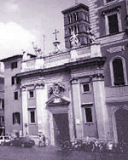
The Station is at the church of Saints Sylvester and Martin, which is one of the most venerable in Rome. It was originally built by Pope St. Sylvester, and still bears his name: but in the sixth century, it was consecrated to St. Martin of Tours. In the seventh century, it was enriched with the relics of Pope Saint Martin, which were brought from Chersonesus, where he had died a martyr a few years before. This church was the first Title of St. Charles Borromeo. It was also that of the learned liturgiologist, the Blessed Joseph-Mary Tommasi, whose body is now venerated in this church, and has been miraculously preserved, even to this day, in a state of incorruption.
Meditation - God's Appeal to All the World
Pilate's "Ecce, Homo!" his appeal to the scornful multitude now on the point of breaking out into mob violence, was even more truly the mighty appeal of God's marvelous mercy to his chosen people and to all the human race.
"Behold the Man!" Behold the Lamb of God, the Son of the living God, in all these unsightly wounds, the most beautiful of men here disfigured beyond recognition, as one stricken by leprosy and all the other filthy diseases of mankind; yes, behold Him here, the most frightful symbol and demonstration of the monstrous evil of mortal sin ever to be given to the world; but even more, behold Him here, the clearest and the mightiest appeal of Heaven to all the world of souls to be converted and to rise from spiritual death to life, true and even divine.
"Behold the Man." O my soul, behold Christ Jesus there as the Lamb of God loaded with your own personal sins and bearing the ghastly wounds your sins inflicted on Him. Pray that you may recognize here, in this reed and purple and crown, God's very own caricature of your senseless pride, of the folly of your imaginary greatness. In that purple rag of a cloak see the sham honor and dignity in which your self-conceit and self-complacency clothe you! In that reed recognize the might of your strength in which you have been trusting. In that crown acknowledge the depth of humiliation you deserve for all your vanity and your open and secret envious ambition for recognition and authority and for honors and offices. O my soul, be honest enough to see and to acknowledge what a spectacle you are to all heaven in the light of the revelation in God's word: "Behold the Man!"
Yet again, "Behold the Man!" Look on Him that you may be filled with hope and courage. Let the crushing truth you have just been making your very own, serve to crush your nauseating and contaminating pride in all its open and especially its hitherto hidden forms. Behold the Man, the Lamb of God laden with your sins, but only to wash them away and to cast them into the deep sea of oblivion; yes, and even to take away your stony heart and give you a heart of flesh, to put His own spirit in your midst, and to cause you to walk in His commandments and to keep His judgments and to do them (Ezech. 36:26-30); in a word, to make a way in your wilderness, that shall be called "The Holy Way." (Isa. 35:6-8.)
Excerpted from Our Way to the Father, Rev. Leo M. Krenz, S.J.
Bl. Clemens August von Galen
Clemens August von Galen was born on 16 March 1878 in Dinklage Castle, Oldenburg, Germany, the 11th of 13 children born to Count Ferdinand Heribert and Elisabeth von Spee.
His father belonged to the noble family of Westphalia, who since 1660 governed the village of Dinklage. For over two centuries his ancestors carried out the inherited office of camerlengo of the Diocese of Münster.
Clemens August grew up in Dinklage Castle and in other family seats. Due to the struggle between Church and State, he and his brothers were sent to a school run by the Jesuits in Feldkirch, Austria.
He remained there until 1894, when he transferred to the Antonianum in Vechta. After graduation, he studied philosophy and theology in Frebur, Innsbruck and Münster, and was ordained a priest on 28 May 1904 for the Diocese of Münster by Bishop Hermann Dingelstadt.
Parish priest, concern for poor
His first two years as a priest were spent as vicar of the diocesan cathedral where he became chaplain to his uncle, Bishop Maximilian Gerion von Galen.
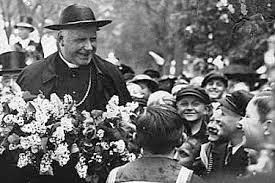 From 1906 to 1929, Fr von Galen carried out much of his pastoral activity outside Münster: in 1906 he was made chaplain of the parish of St Matthias in Berlin-Schönberg; from 1911 to 1919 he was curate of a new parish in Berlin before becoming parish priest of the Basilica of St Matthias in Berlin-Schönberg, where he served for 10 years; here, he was particularly remembered for his special concern for the poor and outcasts.
From 1906 to 1929, Fr von Galen carried out much of his pastoral activity outside Münster: in 1906 he was made chaplain of the parish of St Matthias in Berlin-Schönberg; from 1911 to 1919 he was curate of a new parish in Berlin before becoming parish priest of the Basilica of St Matthias in Berlin-Schönberg, where he served for 10 years; here, he was particularly remembered for his special concern for the poor and outcasts.
In 1929, Fr von Galen was called back to Münster when Bishop Johannes Poggenpohl asked him to serve as parish priest of the Church of St Lambert.
"Nec laudibus, nec timore"
In January 1933, Bishop Poggenpohl died, leaving the See vacant. After two candidates refused, on September 5, 1933 Fr Clemens was appointed Bishop of Münster by Pope Pius XI.
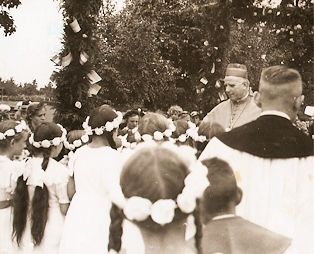 On October 28, 1933 he was consecrated by Cardinal Joseph Schulte, Archbishop of Cologne; Bishop von Galen was the first diocesan Bishop to be consecrated under Hitler's regime.
On October 28, 1933 he was consecrated by Cardinal Joseph Schulte, Archbishop of Cologne; Bishop von Galen was the first diocesan Bishop to be consecrated under Hitler's regime.
As his motto, he chose the formula of the rite of episcopal consecration: "Nec laudibus, nec timore" (Neither praise nor threats will distance me from God).
Throughout the 20 years that Bishop von Galen was curate and parish priest in Berlin, he wrote on various political and social issues; in a pastoral letter dated 26 March 1934, he wrote very clearly and critically on the "neopaganism of the national socialist ideology".
Due to his outspoken criticism, he was called to Rome by Pope Pius XI in 1937 together with the Bishop of Berlin, to confer with them on the situation in Germany and speak of the eventual publication of an Encyclical.
On 14 March 1937 the Encyclical Mit brennender Sorge (To the Bishops of Germany: The place of the Catholic Church in the German Reich) was published. It was widely circulated by Bishop von Galen, notwithstanding Nazi opposition.
"Lion of Munster"
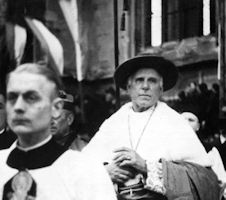 In the summer of 1941, in answer to unwarranted attacks by the National Socialists, Bishop von Galen delivered three admonitory sermons between July and August. He spoke in his old parish Church of St Lambert and in Liebfrauen-Ueberlassen Church, since the diocesan cathedral had been bombed.
In the summer of 1941, in answer to unwarranted attacks by the National Socialists, Bishop von Galen delivered three admonitory sermons between July and August. He spoke in his old parish Church of St Lambert and in Liebfrauen-Ueberlassen Church, since the diocesan cathedral had been bombed.
In his famous speeches, Bishop von Galen spoke out against the State confiscation of Church property and the programmatic euthanasia carried out by the regime.
The clarity and incisiveness of his words and the unshakable fidelity of Catholics in the Diocese of Münster embarrassed the Nazi regime, and on 10 October 1943 the Bishop's residence was bombed. Bishop von Galen was forced to take refuge in nearby Borromeo College.
From 12 September 1944 on, he could no longer remain in the city of Münster, destroyed by the war; he left for the zone of Sendenhorst.
In 1945, Vatican Radio announced that Pope Pius XII was to hold a Consistory and that the Bishop of Münster was also to be present.
Creation of a Cardinal
After a long and difficult journey, due to the war and other impediments, Bishop von Galen finally arrived in the "Eternal City." On 21 February 1946 the Public Consistory was held in St Peter's Basilica and Bishop von Galen was created a Cardinal.
On 16 March 1946 the 68-year-old Cardinal returned to Münster. He was cordially welcomed back by the city Authorities and awarded honorary citizenship by the burgomaster.
On the site of what remained of the cathedral, Cardinal von Galen gave his first (and what would be his last) discourse to the more than 50,000 people who had gathered, thanking them for their fidelity to the then-Bishop of Münster during the National Socialist regime. He explained that as a Bishop, it was his duty to speak clearly and plainly about what was happening.
No one knew that the Cardinal was gravely ill, and when he returned to Münster on 19 March 1946 he had to undergo an operation.
Cardinal von Galen died just three days later, on 22 March. He was buried on 28 March in the Ludgerus Chapel, which has become a place of pilgrimage to this defender of the faith in the face of political oppression.
—©Libreria Editrice Vaticana
Highlights and Things to Do:
- Read this sermon by Bl. Clemens August Count von Galen.
- From Catholic Culture's Library read these inspiring articles on the life of Bl. Clemens August Count von Galen:
- The Cardinal's remains are in the Münster Cathedral in Westphalia, Germany.
- See his listing on Catholic-Hierarchy.


